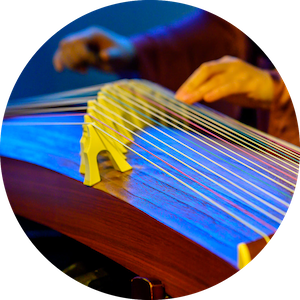Chinese Guzheng
 Bild: Bernd Kumar
Bild: Bernd KumarGuzheng lessons (Overview)
Basic playing skills using left and right hands with supplementary exercises.
– Left hand: pressing strings to change the pitch or glide upwards or downwards; Chinese vibrato (strings tremble slightly to change tone); accompaniment; etc.
– Right hand: Gou, Mo, Tuo, Da (basic playing style with thumb, index finger, middle finger, and the ring finger, with plectrums tied on the fingers); tremolo; etc.
– Both hands playing: chords and arpeggio; overtones; etc.
Basic knowledge of Chinese traditional music
– Tonality: pentatonic
– Notation for Chinese traditional music: number notation
Traditional and modern works of the Guzheng (can be chosen according to student’s wishes)
Learn more about the instrument Guzheng
The guzheng is a Chinese plucked zither. The modern guzheng commonly has 21 strings, is 1.6 meter long, and is tuned in a major pentatonic scale. It has a large, resonant soundboard made from Paulownia wood. Guzheng players often wear fingerpick made from materials such as plastic or resin on one or both hands. The high-pitched strings of the guzheng are close to the player, and the low-pitched strings are on the opposite side.
The guzheng is ancestral to several other Asian zithers such as the Japanese koto, the Korean gayageum and ajaeng, Mongolian yatga, the Vietnamese đàn tranh, the Sundanese kacapi, and the Kazakhstan jetigen.
The guzheng has gone through many changes during its long history. The oldest specimen yet discovered held 13 strings and was dated to possibly during the Warring States period (475–221 BCE). The guzheng became prominent during the Qin dynasty (221–206 BCE). By the Tang Dynasty (618–907 CE), the guzheng was perhaps the most commonly played instrument in China. The guzheng is played throughout all of China with a variety of different techniques, depending on the region of China and the time period. It has a light timbre, broad range, rich performance skills, and strong expressive power, and it has been deeply loved by many Chinese people throughout history.


